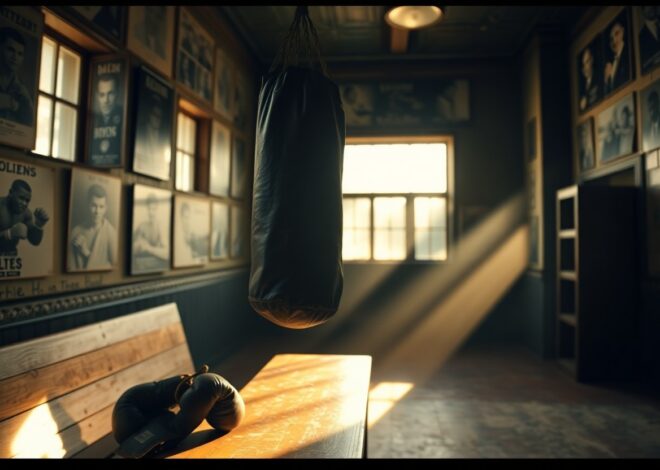
From Underdogs To Champions: Inspiring Journeys Of Boxing Greats
Boxing is a sport defined by its intensity, perseverance, and raw determination. This guide shines a spotlight on the remarkable stories of esteemed champions who once faced overwhelming odds. From humble beginnings to legendary titles, these athletes exemplify how grit and resolve can lead to greatness. Each journey is a testament to the power of the human spirit, illustrating that every champion was once an underdog fighting for recognition and success.
Most legendary boxers began their careers as underdogs, facing steep challenges and overwhelming odds. Their journeys reveal not just incredible talent but also sheer determination and resilience that propelled them to greatness. This guide explores the transformative stories of these fighters, illustrating how they overcame adversity to become champions. By examining their unique paths, we gain valuable insights into the dedication and tenacity required to succeed in the boxing world.
Types of Boxers
Boxers come in various styles and categories, each with unique traits that define their approach to the sport. Understanding these distinctions enhances appreciation for the sport and the fighters’ strategies.
- Amateur Boxers
- Professional Boxers
- Power Punchers
- Defensive Specialists
- Boxer-Punchers
This variety showcases the diversity in boxing techniques and philosophies.
| Type of Boxer | Description |
|---|---|
| Amateur Boxers | Compete in leagues and tournaments, often focusing on points rather than knockouts. |
| Professional Boxers | Fight for titles, purses, and rankings, often showcasing power and skill. |
| Power Punchers | Known for their knockout ability, they rely on strength and timing. |
| Defensive Specialists | Focus on evading blows and scoring points through precision and technique. |
| Boxer-Punchers | A blend of skill and power, capable of both outboxing and knocking out opponents. |
Amateur Boxers
Amateur boxers typically start their careers in local gyms and clubs, competing in a series of matches, including regional and national tournaments. Their fights focus on scoring points over knockouts, emphasizing technique, speed, and strategy. Many go on to represent their countries in international competitions, including the Olympics, showcasing rising talents.
Professional Boxers
In contrast to their amateur counterparts, professional boxers fight for monetary rewards and championship titles, shaping various weight classes in the sport. These athletes train rigorously to hone their skills and increase their striking power, cooperation, and endurance, making it crucial for them to understand both the business and the sport of boxing.
Professional boxers often begin their careers in the amateur circuit, demonstrating exceptional talent that leads to lucrative contracts. They face a demanding schedule, with bouts potentially every few months, requiring increased focus on physical conditioning and mental resilience. Champions like Mike Tyson and Floyd Mayweather Jr. have transformed the profession, blending athleticism with showmanship, while becoming global icons through their performance and lifestyle. The professional landscape allows for significant financial incentives, elevating boxing into a mainstream sport where talent meets opportunity on a grand scale.
Inspiring Journeys of Champions
Boxing greats have often transformed their struggles into stories of triumph, embracing challenges that molded them into formidable champions. These athletes did not merely overcome physical opponents; they battled their own limitations, societal expectations, and personal demons. Each journey reflects the essence of resilience, portraying how the spirit of determination can lead from the depths of despair to the heights of success.
Early Struggles
In the beginning, champions like Mike Tyson faced dire circumstances, growing up in poverty and experiencing the harsh realities of life on the streets. Similarly, Muhammad Ali, initially facing discrimination and opposition, used his voice and fists to combat the struggles imposed by society. These early challenges shaped their determination, sparking an unwavering resolve to succeed.
Key Turning Points
Turning points in a champion’s journey can redefine their trajectory. For instance, Floyd Mayweather Jr. faced a pivotal moment when he switched from being a junior lightweight to a superstar after defeating Arturo Gatti in 2005. This victory not only boosted his confidence but also solidified his place among boxing elites, leading him to become one of the highest-paid athletes in the world.
The defining moments often consist of significant fights that change an athlete’s career. Rocky Marciano, for example, achieved a remarkable 49-0 record, but his pivotal clash with Jersey Joe Walcott in 1952, where he was trailing before landing a devastating knockout, solidified his legacy. Similarly, Oscar De La Hoya‘s fight against Julio Cesar Chavez in 1996 marked a cultural shift in boxing, bridging fans across demographics. These milestones not only highlight their skills but also illustrate the power of believing in oneself during adversity.
Key Factors to Success in Boxing
Success in boxing is influenced by several key factors that distinguish champions from the competition. These elements include:
- Mental Toughness
- Physical Conditioning
- Technique and Skill Development
- Discipline and Work Ethic
- Support Systems
Assume that mastering these components forms the backbone of a boxer’s journey from underdog to champion.
Mental Toughness
Mental toughness stands as a defining trait among boxers, enabling them to push through pain, setbacks, and intense competition. Champions like Mike Tyson exemplified this by overcoming personal and professional challenges, maintaining focus during fights, and bouncing back from defeats.
Physical Conditioning
Physical conditioning is foundational in boxing, comprising rigorous training, strength building, and cardiovascular endurance. A champion’s regimen typically includes long runs, sparing sessions, and targeted strength workouts, ensuring they’re in peak form to withstand the rigors of a fight.
Boxers often follow a well-structured training plan that incorporates various elements. For instance, a mix of sprints and long-distance runs enhances cardiovascular fitness, while weight training develops strength and power. The goal is to achieve peak performance levels, allowing boxers to sustain high energy during bouts and recover quickly afterwards. Additionally, nutrition plays a significant role, with champions adhering to strict diet plans that fuel their demanding training schedules.
Tips for Aspiring Boxers
Aspiring boxers should focus on maintaining a disciplined approach to their training and development. Key elements include setting clear goals, committing to a rigorous training schedule, and prioritizing physical fitness. Additional tips include:
- Consistency in workouts
- Nutrition that supports performance
- Mentorship from experienced trainers
- Mental resilience to overcome challenges
- Technique mastery to ensure safety and effectiveness
Perceiving the journey to becoming a champion requires dedication and a willingness to learn from both victories and defeats.
Training Regimens
A well-structured training regimen for boxers typically includes a blend of strength training, cardio, and skill work. This balanced approach not only enhances physical prowess but also refines technique. Most boxers spend at least 6-8 hours per week training, integrating sparring sessions, bag work, and footwork drills. A tailored routine helps maintain peak performance while reducing the risk of injury.
Importance of Mentorship
Having a mentor is a significant advantage for aspiring boxers. A seasoned trainer not only provides technical guidance but also invaluable insights into the mental aspects of the sport. They can help navigate the complexities of competition and personal development, ensuring that young boxers can avoid common pitfalls. Those with strong mentorship often see accelerated progress in their skills and confidence.
Mentorship goes beyond technical training; it fosters an environment of support and accountability that is crucial for growth. Mentors can share their personal experiences, helping young athletes understand the importance of discipline and perseverance. Successful boxers often credit their mentors for shaping their careers, providing both motivation and direction during challenging times in and out of the ring.
Step-by-Step Path to Greatness
| Key Steps | Description |
| Setting Goals | Define short-term and long-term objectives to guide training and focus. |
| Building a Support System | Surround yourself with mentors, trainers, and peers who encourage growth. |
Setting Goals
Establishing clear goals allows boxers to create a roadmap for their journey. Short-term goals, like improving specific techniques or increasing stamina, offer immediate benchmarks to assess progress. Long-term goals, such as winning a championship title, serve as motivational anchors, pushing athletes to stay committed despite challenges.
Building a Support System
A robust support system is vital for any boxer aspiring to greatness. Having experienced mentors, dedicated trainers, and like-minded peers fosters an environment that encourages skill development and emotional resilience.
A strong support network can significantly influence a boxer’s journey. Mentors often share invaluable insights, such as strategy and mindset adaptations gained through years of experience. Trainers provide tailored workouts and constructive feedback, ensuring continuous improvement. Peers in the gym can motivate with camaraderie and friendly competition, creating a community that bolsters commitment and pushes athletes to hold themselves accountable. Furthermore, family members can be vital in providing emotional backing during the tough periods of training or competition, reinforcing a boxer’s determination to achieve their goals.
Pros and Cons of a Boxing Career
| Pros | Cons |
|---|---|
| Potential for significant financial rewards | High risk of injury |
| Fame and recognition | Short career span |
| Improved physical fitness | Intense training schedules |
| Networking opportunities | Emotional stress and pressure |
| Ability to inspire others | Weight management challenges |
| Personal discipline and resilience | Potential for exploitation by promoters |
| Supportive community | Long-term health complications |
Financial Benefits
The financial rewards in boxing can be substantial, with top fighters earning millions through sponsorships, pay-per-view events, and lucrative contracts. For example, champions like Floyd Mayweather Jr. and Canelo Alvarez can command purse bids in the range of $30 million to over $100 million per fight. Even lesser-known boxers can generate income through sponsorship deals and merchandise sales, providing a pathway to financial stability and independence.
Health Risks
Boxing carries significant health risks, including concussions, traumatic brain injuries, and chronic conditions like CTE (Chronic Traumatic Encephalopathy). These risks stem from repeated head trauma sustained during fights and sparring. While protective gear and training can mitigate some dangers, the nature of the sport inevitably exposes boxers to severe physical and psychological effects.
Additionally, studies have shown that boxers can suffer long-term neurological impairments due to the cumulative impact of head injuries. For instance, data from the Journal of Neurology indicates that fighters may experience memory loss, mood disorders, and decreased cognitive function as a result of their boxing careers. The temptation to push through injuries can further exacerbate these risks, leading to dire consequences for many athletes.
Step-by-Step Guide to Starting in Boxing
| Step | Description |
| Choosing the Right Gym | Find a gym with experienced trainers and a supportive environment. |
| Setting Goals | Establish clear, measurable objectives for your boxing journey. |
Choosing the Right Gym
Picking the right gym impacts your progression significantly. Look for facilities that feature qualified coaches with a proven track record and an atmosphere that encourages community support. Visiting multiple gyms and observing training sessions will help in assessing the vibe and the quality of the coaching staff, which can be a game changer for your boxing journey.
Setting Goals
Defining your boxing aspirations shapes your training approach. Outline short-term targets, such as completing a specific number of training sessions weekly, alongside long-term ambitions like competing in local matches. This clarity ensures focused training and motivates continuous improvement, allowing you to track progress and celebrate achievements.
Setting clear goals also enables you to align your training efforts with specific milestones, such as gaining skills for sparring or improving your conditioning. Each goal should be realistic yet challenging, fostering a balanced path. For instance, aspiring boxers might aim for a fight within six months after starting, integrating techniques learned during training with a timeline for skill acquisition. This step-by-step approach not only nurtures discipline but also builds confidence as you progress.
Lessons Learned from Boxing Greats
Boxing legends offer invaluable insights that extend beyond the ring. Their journeys reveal that success often relies on understanding both victories and setbacks. The stories of champions like Muhammad Ali, Mike Tyson, and Canelo Alvarez exemplify how overcoming adversity shapes character and skill. Each punch thrown serves as a testament to their dedication and a reminder that true greatness is forged through experience and learning from every encounter.
The Role of Losses
Losses in boxing are not just defeats; they serve as pivotal learning moments for champions. Boxers like Gennady Golovkin and Leon Spinks faced setbacks that forced them to reassess strategies and improve their game. These experiences cultivate humility and grit, crucial traits that elevate fighters from merely skilled to truly exceptional.
Persistence and Resilience
Persistence and resilience manifest in boxing through unyielding training and mental fortitude. A fighter like Oscar De La Hoya capitalized on his failures, using them as stepping stones toward greatness. Resilient boxers embrace challenges, knowing that enduring hardship often paves the way for spectacular comebacks and triumphant victories.
The tale of resilience is embodied in the career of Manny Pacquiao, who transformed his early defeats into motivation for relentless improvement. Through rigorous training and a refusal to back down, Pacquiao illustrates how an unwavering spirit can lead to an impressive record, including world titles across eight weight classes. Persistence and resilience are foundational for boxers, enabling them to rise after each fall and build a legacy that inspires future generations.
Final Words
With these considerations, the inspiring journeys of boxing greats illustrate that determination, resilience, and hard work can transform underdogs into champions. Their stories serve as powerful reminders of the human spirit’s capacity to overcome immense challenges and achieve greatness. By studying the paths taken by these athletes, we gain valuable insights into the importance of perseverance, discipline, and mindset in the pursuit of success both in and out of the ring.
FAQ
Q: What is the primary focus of “From Underdogs To Champions – Inspiring Journeys Of Boxing Greats”?
A: The book highlights the life stories and challenges faced by various boxing legends, illustrating their paths from humble beginnings to achieving greatness in the sport.
Q: Who are some of the boxing greats featured in the book?
A: The book includes accounts of renowned boxers such as Muhammad Ali, Mike Tyson, and Manny Pacquiao, showcasing their unique struggles and triumphs throughout their careers.
Q: What lessons can readers take away from the stories in this book?
A: Readers can gain insights on resilience, determination, and the importance of hard work, showing how these attributes have propelled boxers to success against all odds.



